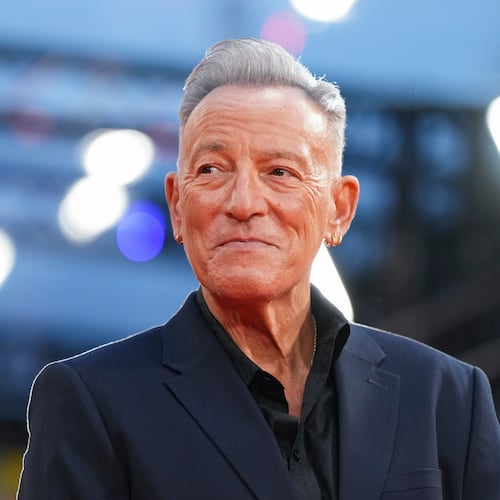One of the popular stories to come out of Sundance 2025 was the underwhelming impact on both audiences and buyers of the big-name narrative films. We found ourselves largely in agreement with that assessment, with the notable exception of Cooper Raiff’s episodic treat “Hal and Harper,” costarring Mark Ruffalo.
But man oh man, did the documentaries fill in the gap this year at Sundance, which bills itself as “the ultimate gathering of original storytellers and audiences seeking new voices and fresh perspectives.” A gorgeous remembrance of one of the most promising voices in rock history, a tragic tale of a neighborhood dispute gone wrong told primarily through bodycam footage, and a courageous reexamination of a legendary but problematic TV show were among the highlights. But nothing thrilled us more than “Come See Me in The Good Life,” the story of iconic spoken word poet Andrea Gibson’s struggle with terminal cancer. Thanks to the documentarians, what may be the festival’s next to last edition in Park City, Utah, ended Feb. 1 with a bang.
It will take a while to sort out which titles will receive theatrical release and which will become available on streaming platforms, or both, but here is our top 10.
Credit: Photo courtesy of Sundance Institute
Credit: Photo courtesy of Sundance Institute
“BLKNWS: Terms & Conditions”
“BLKNWS: Terms & Conditions” doesn’t take long to inform us that it’s not a documentary. And it isn’t. And yet, it does have docu-fiction elements melded together with an art film aesthetic and a future history storyline running throughout. Filmmaker Kahlil Joseph weaves entries from W.E.B. DuBois’ encyclopedic project (later completed and published by Louis Gates Jr. and Kwame Anthony Appiah in 1999), “Africana: The Encyclopedia of the African and African American Experience” throughout the film, creating a backbone of proud Black history moments. Built on top of that framework are afro-futurist story elements involving a fictional trans-Atlantic Biennale held on a cruise ship that would be at home in any science fiction novel. “BLKNWS” suffers from some weak narrative portions that are nevertheless overshadowed by the daring and dense visual world the film creates.
“Come See Me in the Good Light”
It’s impossible to write about Ryan White’s magisterial “Come See Me in the Good Light” without getting emotional. Technically it’s the story of poets and partners Andrea Gibson and Megan Falley as they confront and fight through Gibson’s terminal cancer diagnosis. But it’s so much more than that. It’s a tribute to Gibson’s stunning writing and performance, and that alone would have been enough for a compelling film. It’s also a reminder that there are small moments in life like having a never-ending roadside mailbox situation, a small yet humorous storyline running throughout the film, and monstrously huge moments where everything feels like it’s crashing around us and we need someone to walk us to the car while we hyperventilate. It’s a reminder that all of these moments, the funny, happy, devastating, and crushing among them, can help us to truly live, if we only allow ourselves the space to embrace the mystery. Our favorite film of Sundance 2025.
“Didn’t Die”
When Vinita (Kiran Deol, in a breakout performance) starts narrating as the host of her “Didn’t Die” podcast, you can’t help but feel an uncomfortable familiarity. Though the story is about a zombie plague that has enveloped the world, Vinita and her listeners experience similar issues we all lived through during the recent pandemic. Feelings of isolation, dread, and a desperation for normalcy abound when an old flame played by George Basil bursts into a meetup of podcast fans with a baby and a terrifying update about the state of the new normal. But at its core, director Meera Menon’s “Didn’t Die” isn’t a zombie movie. It’s a sweet, funny, and occasionally scary story of a family trying to cope in the midst of a world turned upside down.
Credit: Photo courtesy of Sundance Institute
Credit: Photo courtesy of Sundance Institute
“East of Wall”
Director Kate Beecroft’s “East of Wall” focuses on Tabatha and her daughter Porshia Zamiga, non-actors playing themselves, who live in a trailer on a desolate horse ranch near Wall, South Dakota. Tabatha is a horse trainer who begins taking in wayward teens from the area whose families can’t, or in some cases won’t, parent them, after her partner dies unexpectedly. Her new ragtag family is a fascinating mix of the American West and punk rockers with half-shaved heads and dusty cowboy boots. Beecroft lived with her subjects for three years to tell a story authentic to their experience, and it shows. At its heart, “East of Wall” is a fiercely female-centric story of hard lives and hard-won victories over adversity. Our favorite narrative film of Sundance 2025.
“Hal & Harper”
Watching this episodic drama series is like spending time with your most charming yet highly dysfunctional family members. You’re delighted by them and their presence on screen and yet can’t look away from the deep flaws that they try to hide as they navigate life, grief and trauma. Hal, played by Cooper Raiff, also the writer and director, is the younger brother of Harper (Lili Reinhart). When their mother passes away, their dad, the wonderful Mark Ruffalo struggles to parent Hal and Harper, and they are left to mostly take care of themselves, with Harper taking on a more motherly role as the older sister. The series is both amusing and heartbreaking, sometimes all at once. And yet, through the tears and uncomfortable silences, a beautiful picture of a family finding themselves again emerges. Our favorite narrative experience of Sundance 2025.
Credit: Photo courtesy of Sundance Institute/Merri Cyr
Credit: Photo courtesy of Sundance Institute/Merri Cyr
“It’s Never Over, Jeff Buckley”
Director Amy Berg, who has one Oscar nomination under her belt for 2006′s “Deliver Us From Evil” and arguably should have at least two more (for 2012′s “West of Memphis” and 2015′s “Prophets Prey”), is no stranger to documentaries that tackle larger-than-life and impossible-to-summarize figures, having directed a masterful Janis Joplin doc (“Janis: Little Girl Blue”). So she was a perfect fit for the story of the enigmatic genius Jeff Buckley, the estranged son of folk legend Tim Buckley who made a single full album (one that David Bowie called the greatest ever made), and then drowned in Memphis before he could complete a follow-up. Many casual fans only know Buckley as the foremost interpreter of Leonard Cohen’s “Hallelujah,” and misremember that he died of an overdose, or that he was high when he drowned (he wasn’t). For those fans, Berg’s doc will be a way to explore more of Buckley’s story, but even for those of us more intimately familiar with his career, there is much new here. For both audiences, the still-raw emotion with which those closest to him discuss his life and work is moving. And Berg uses abstract, pulsing animation to great effect, including the most beautiful, gentle depiction I’ve ever seen on film of the death of a beloved figure. Some great documentaries are only for some audiences, but the powerful “It’s Never Over, Jeff Buckley” is a feast for everyone.
Credit: Photo courtesy of Sundance Institute
Credit: Photo courtesy of Sundance Institute
“Mr. Nobody Against Putin”
We all like to think that, confronted with a government of pure evil, we’d stand up and resist, whatever the cost. To put it bluntly, most of us are deluding ourselves. But Pavel Talankin, the titular Mr. Nobody of David Borenstein’s moving documentary (Talankin himself codirected), is doing just that. An elementary school teacher in an obscure Russian mining town in the Ural Mountains, he becomes increasingly horrified at the rising militarism of Putin’s Russia and the effects it has on his students and his town and decides to use his video education program to document it all. His classroom becomes a safe haven for dissident students, providing a uniquely Russian twist on the old inspiring-iconoclastic-teacher tale. It’s an incredibly moving story.
Credit: Photo courtesy of Sundance Institute
Credit: Photo courtesy of Sundance Institute
“The Perfect Neighbor”
When I tell you that “The Perfect Neighbor,” a story about a neighborhood conflict gone tragically wrong, is told nearly exclusively through bodycam and monitor footage, you’re sure to assume that the documentary will be difficult to engage with and that much of the connective tissue of the story will have to be provided by you as the viewer, an exhausting process. Nothing could be further from the truth. Geeta Gandbhir’s film would not have been improved one ounce by any additional footage, and the immediacy provided by the form brings its own rush and thrill. The story is gripping and tragic, and, with one notable exception, Gandbhir allows viewers to draw their own conclusions at every step along the way. And the people. Oh, those people. Even the minor characters are hugely compelling. My experience of watching “The Perfect Neighbor” was a parallel to that of watching Jason Osder’s all-found-footage masterpiece “Let the Fire Burn” — initial skepticism that the format could be pulled off, then amazement at how well it was done, then being completely immersed in the story without even thinking about technique. Bravo.
Credit: Photo courtesy of Sundance Institute
Credit: Photo courtesy of Sundance Institute
“Predators”
The word “brave” gets thrown around far too often in discussions of documentaries, but David Osit’s “Predators” is a true work of bravery. It would have been an easy choice to tell a rah-rah story of how Chris Hansen’s hit show “To Catch a Predator” ensnared and humiliated men attempting to have clandestine rendezvous with underage boys and girls, and, indeed, for the first part of the film, it seems that’s just what we’re getting. But Osit has something much more profound in mind. The tide begins to turn with his examination of an infamous episode where the subject killed himself rather than be caught. Osit goes further and begins, counterintuitively, to examine how much good the show did, in fact, accomplish. In his attempts to discover more about the motivations of the men, he even manages to ask if we can somehow find it in ourselves to see their humanity. Along the way, we learn that Osit himself has good reason to seek those answers. It all builds to a dramatic climax where Osit is able to sit down with Hansen and challenge him on some of these issues. The aftermath of that interview, which closes the film, is quietly emotionally devastating. Earlier, in perhaps the most profound moment of any film at Sundance this year, a woman is booking a perp who is utterly devastated and destroyed, and she put a hand on his arm and says kindly, “You know what John? You’re going to live through this.” Any film that can make us think this hard about our preconceptions, and feel this much emotion as well, is a profound achievement indeed.
Credit: Photo courtesy of Sundance Institute/Sara Mishara
Credit: Photo courtesy of Sundance Institute/Sara Mishara
“Two Women”
At the outset of “Two Women,” Violette (Laurence Leboeuf) calls in her neighbor Florence (a ferocious Karine Gonthier-Hyndman) to complain that she can hear her orgasms through the thin wall their apartments share. But, as it turns out, Florence and her husband haven’t had sex in years. Both women become fascinated not only with the mystery of where those mysterious crow-like caws may be coming from, but also with their shared lack of sexual fulfillment, and they begin to compare notes on the flings they are having. Director Chloé Robichaud may be Quebecoise, but the film definitely takes on the tenor of a classic French sex farce (it is in fact a remake of a 1970s film), while at the same time providing some moments of real tenderness and empathy for its characters, especially Gonthier-Hyndman, whose performance as a middle-aged bourgeois woman yearning for her days of youthful abandon was one of the most arresting of the festival.
About the Author
Keep Reading
The Latest
Featured










